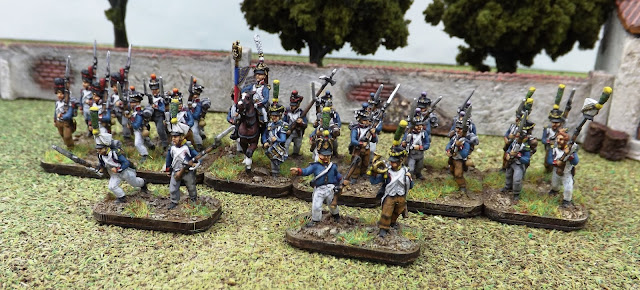The 94e Regiment de Ligne can trace its heritage back to January 1st 1709 when the Regiment Royal Baverie was raised for the War of Spanish Succession by the Comte de Baviere, son of the Elector of Bavaria and was the last regiment raised during the reign of Louis XIV of France.
 |
| Comte Emmanuel-Francois-Joseph de Baverie |
During the Seven Years War 1756 -1763 the regiment was ranked 101st seeing service in the European theatre with participation in the Battles of Hastenbeck (1757), Battle of Bergen (1759) and Battle of Minden (1759).
In 1760 the regiment raised a third battalion and was in action against an Anglo-Hanoverian force under Ferdinand the Prince of Brunswick at Emsdorf where it lost 300 men and its Colonel, Count von Helffenberg killed by a cannon shot, with the regiment managing to retire whilst narrowly avoiding encirclement.
Battle of Emsdorf
On April 15th 1780 the regiment came under the command of Louis IX, Landgrave of Hesse Darmstadt and changed its name to the Regiment Royal Hesse Darmstadt. It would see service during the American War of Independence as part of the French expeditionary forces.
In 1791, with the incorporation of the foreign regiments into the French army, the regiment was retitled the 94e Regiment d'Infanterie, later becoming the 94e demi-brigade de bataille in 1794 as the French restructured their forces to fight the Revolutionary War.
In 1794 the 94e demi-brigade de bataille consisted of the following units:
2e bataillon, 47e Regiment d'Infanterie
1er bataillon, Volontaires de Saone-et-Loire
1er bataillon, Volontaires du Cher
6e bataillon, Volontaires de lYonne
Detatchment of Volontaires de Marne-et-Loire
In 1796 the composition of the 94e demi-brigade changed again:
171e demi-brigade de bataille (1er Bataille 94e Regiment d'Infanterie, 1er bataillon, Volontaires des Pyrenees-Orientales and the 6e bataillon, Volontaires de Saone-et-Loire)
2e bataillon, Volontaires des Vosages
4e bataillon, Volontaires du Haute-Rhin
5e bataillon, Volontaires du Bas-Rhin
7e bataillon, Volontaires du Jura
During this period the the regiment would see service at Valmy and Jemmapes (1792), Nerwinden (1793), Arlon, Fleurus and Aldenhoven (1794) and the expedition to Ireland (1796)
In 1803, and the accession of Napoleon, the regiment was retitled the 94e Reiment d'Infanterie de Ligne under Colonel Jean-Nicolas Razout. With Colonel Razout's promotion to General de Brigade in 1807, the regiment came under the command of Colonel Jean-Antoine-Francois Combelle who would lead the 94e Ligne through to 1813.
 |
| Colonel Razout |
Depictions of the 94e Ligne are limited and so I have based the look of my regiment on the Otto manuscript illustrations seen above showing the sappeur and soldiers of the elite companies as they looked in 1807 in Hamburg. The grenadier is pictured wearing the bearskin with red rather that white chords and the voltigeur with yellow rather than green chords.
The sappeur can be seen sporting light blue facings, possibly reflecting the light blue coat colour worn as a German regiment in the old French Royal army, and I aim to include a suitable figure in one of my three battalions and have adopted the light blue facings to adorn my musicians.
My 1/94e Ligne are composed of figures from AB carrying a Colour from GMB Flags
Sources consulted for this post included:
Napoleon's Line Infantry, Haythornthwaite and Fosten - Osprey Men at Arms
French Napoleonic Line Infantry - Emir Bukhari
Napoleon's Soldiers, The Grande Armee of 1807 (The Otto Manuscript) - Guy C Dempsey Jr.
https://en.wikipedia.org/wiki/94th_Infantry_Regiment_(France)
http://www.napoleon-series.org/military/organization/c_frenchinf10.html
http://www.wikiwand.com/de/94e_r%C3%A9giment_d%E2%80%99infanterie
https://fr.wikipedia.org/wiki/94e_r%C3%A9giment_d%27infanterie










Fine brushwork as always, Jonathan.
ReplyDeleteLovely work!
ReplyDeleteVery nice Jonathan .
ReplyDeleteRegards Gavin .
Very nice JJ. I think you have painting 15/18mm French "off pat" now.
ReplyDeletePersonally I think painting smaller figures needs totally different techniques to those used on their 28/30mm bretheren. I have noticed that your style has changed from your first units, with more contrast in high/low lights. Given that you have so much less to work with in a smaller figure, I think this is needed to "suggest" details that would be modelled in 28mm, but cannot be reproduced in 18mm scale without cluttering the model.
Keep up the good work.
Vince
Thanks for your comments chaps and apologies for a late reply - Easter Bank holidays and work!!
ReplyDeleteGood point Vince, I have definitely moved to more daring options for the lighter shades to help the 18mm figures pop more on the table, something that can be much more subtle when painting a 28mm
Cheers
JJ